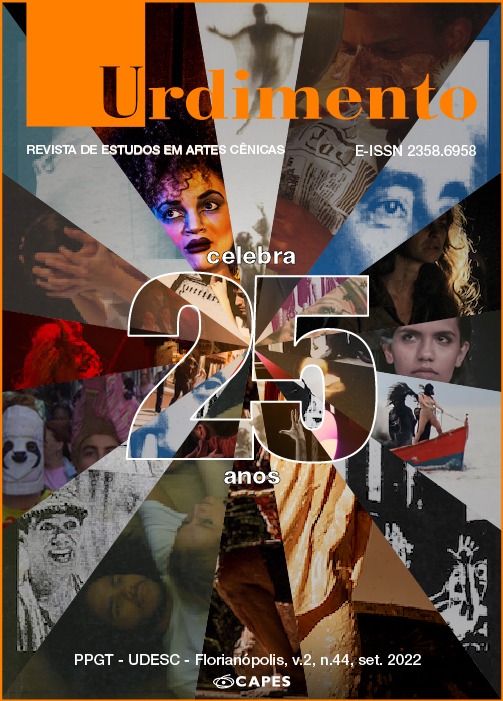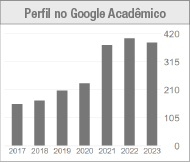Dances of Black Families: Notes on learning the São Gonçalo de Amarante Dance
DOI:
https://doi.org/10.5965/1414573102442022e0102Keywords:
dance, learning, culture, ancestryAbstract
This article aims to share reflections on the studies of Dances of Black families. To achieve this, the process of teaching-learning of São Gonçalo de Amarante Dance, a kind of family manifestation produced in the Quilombola settlement of Mussuca in Laranjeiras, Sergipe – Brazil, was observed. We started with the question "how do children learn to dance the São Gonçalo Dance in the family context of Mussuca?". It was considered that the fundamentals concerning the learning of the São Gonçalo Dance are based on processes linked to empirical practice, repetition and family experience. Furthermore, notes were established for the definition of Black family dances and the practices related to the learning of these dances were discussed through a study focused on the São Gonçalo de Amarante Dance.
Downloads
References
ACSELRAD, Maria. Viva Pareia: Corpo, Dança e Brincadeira no Cavalo Marinho de Pernambuco. Recife: Editora Universitária da UFPE, 2013.
BOMFIM, Wellington de Jesus. Identidade, Memória e Narrativas na Dança de São Gonçalo do Povoado Mussuca (SE). 2006. Dissertação (Mestrado em Antropologia Social) – Universidade Federal do Rio Grande do Norte, 2006.
CASCUDO, Câmara. Dicionário do Folclore Brasileiro. São Paulo: Global, 2012.
GONÇALVES, Renata de Sá. A Dança Nobre no Espetáculo Popular: A Tradição como Aprendizado e Experiência. 2008. Tese (Doutorado em Ciências Humanas/ Antropologia Cultural) – Universidade Federal do Rio de Janeiro, 2008.
KAEPPLER, Adriene L. Dança e o Conceito de Estilo. In.: CAMARGO, Gisele Guilhon Antunes (Org.). Antropologia da Dança I. Florianópolis: Insular, 2013.
KEALIINOHOMOKU, Joann. Folk Dance. In.: DORSON, Richard M. (Editor). Folklore and Folklife: An Introduction. Chicago: The University of Chicago Press, 1982.
MARTINS, Leda Maria. Performances do Tempo Espiralar: poéticas do corpo-tela. Rio de Janeiro: Cobogó, 2021.
MAUSS, Marcel. Sociologia e Antropologia. São Paulo: Cosac Naify, 2011.
MOURA, Clóvis. Rebeliões da Senzala: Quilombos, Insurreições e Guerrilhas. Porto Alegre: Mercado Aberto, 1988.
NASCIMENTO, Beatriz. My Internal Blackness. Journal Village Voice, New York, 1982.
NASCIMENTO, Beatriz. O Conceito de Quilombo e a Resistência Cultural Negra. In.: RATTIS, Alex. Eu sou Atlantica. São Paulo: Instituto Kuanza, 2006.
OLIVEIRA, Victor Hugo Neves de. Dançando com Gonçalo: Uma Abordagem de Antropologia-Dança. 2016. Tese (Doutorado em Ciências Sociais) – Universidade Federal do Rio de Janeiro, 2016.
OLIVEIRA, Victor Hugo Neves de. O cão celebra com o rabo, mas morde com a boca: pistas iniciais para a produção de uma dança preta. Revista Rascunhos - Caminhos da Pesquisa em Artes Cênicas, [S. l.], v. 7, n. 1, 2020.
DOI: 10.14393/issn2358-3703.v7n1a2020-03. Disponível em: https://seer.ufu.br/index.php/rascunhos/article/view/55524. Acesso em: 13 jan. 2022.
OLIVEIRA, Victor Hugo Neves de. Por uma dança que não seja “popular”: algumas pistas sobre a questão das hierarquias na dança. PÓS: Revista do Programa de Pós-graduação em Artes da EBA/UFMG, [S. l.], p. 167–183, 2018. Disponível em: https://periodicos.ufmg.br/index.php/revistapos/article/view/15610. Acesso em: 29 dez. 2021.
PRICE, Sally. Arte Primitiva em Centros Civilizados. Rio de Janeiro: Editora UFRJ, 2000.
SANTOS, Andreilton dos. Entrevista sobre Aprendizagem da Dança de São Gonçalo de Amarante concedida ao autor. Mussuca (Laranjeiras/SE), março de 2015.
SANTOS, Henrique dos. Entrevista sobre Aprendizagem da Dança de São Gonçalo de Amarante concedida ao autor. Mussuca (Laranjeiras/SE), março de 2015.
SILVA, Renata de Lima; FALCÃO, José Luiz Cirqueira; MIRANDA, Elderson Melo. A presença do riso na Capoeira Angola. Urdimento - Revista de Estudos em Artes Cênicas, Florianópolis, v. 2, n. 38, p.1-23, 2020. DOI: 10.5965/14145731023820200041. Disponível em: https://www.revistas.udesc.br/index.php/urdimento/article/view/16857. Acesso em: 13 jan. 2022.
Published
How to Cite
Issue
Section
License
Copyright (c) 2022 Urdimento - Revista de Estudos em Artes Cênicas

This work is licensed under a Creative Commons Attribution 4.0 International License.
Copyright Statement
The articles published by the magazine are free to use. The copyright is all assigned to the magazine. The articles whose authors are identified represent the expression from the point of view of their authors and not the official position of the journal Urdimento. The author (s) undertakes whenever publishing material relating to the article published in Revista Urdimento mention the said publication as follows: This article was originally published by Urdimento magazine in its volume (put the volume), number (put the number) in the year of (put the year) and can be accessed at:
http://www.revistas.udesc.br/index.php/urdimento
This work is licensed under a Creative Commons Attribution 4.0 International License.




